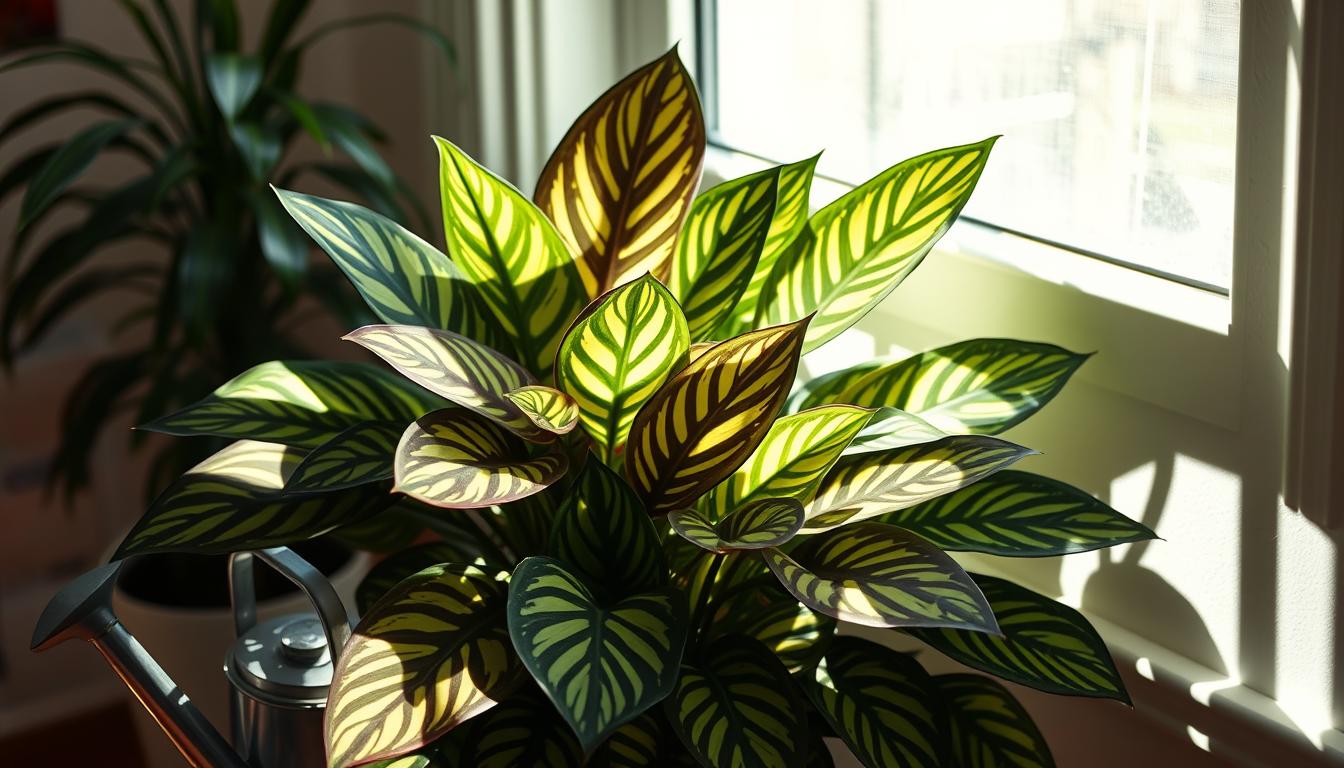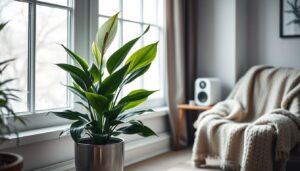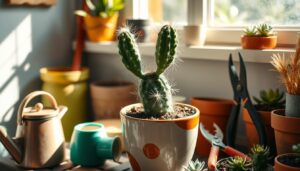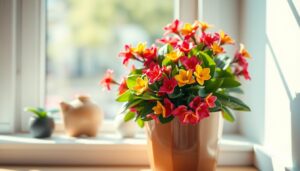Looking for a pet-friendly houseplant that’s easy to care for? The Prayer Plant, or Maranta leuconeura, is a great pick. It has beautiful leaves and is not hard to take care of. To start, you need to know the basics of caring for it, like light, water, and food.
The Prayer Plant loves bright, indirect light and a bit of humidity. It’s safe for cats, dogs, and people, making it perfect for homes with pets. Learning how to care for your Prayer Plant means giving it the right soil, water, and food. This is key to keeping it happy and healthy.
By caring for your Prayer Plant right, you’ll enjoy its beauty and health benefits. It’s great for air quality too. Whether you’re new to plants or not, caring for a Prayer Plant is a wonderful way to add green to your home. It’s safe for your pets too. So, let’s begin your journey in prayer plant care and enjoy this special, safe houseplant.
Understanding the Prayer Plant’s Unique Characteristics
The Prayer Plant folds its leaves up at night, like praying. This is called “nyctinasty.” It happens because of light levels. The leaves open flat in the day and curl up at night.
This helps the plant save energy and stay safe from cold or hot temperatures.
Knowing about prayer plant care is key. The Prayer Plant has many types, each needing different things. You might have a Maranta leuconeura, Maranta tricolor, or Maranta warocqueana.
- It changes its leaf position with the light.
- There are many types, each special in its own way.
- Its leaves move like hands in prayer.
By understanding these traits, you can take great care of your Prayer Plant. You’ll love watching it move and grow.
Creating the Perfect Environment for Your Prayer Plant
To make your prayer plant happy, you need to give it the right home. It loves bright, indirect light. You can put it near a window with a curtain or use grow lights.
Don’t let it get too much direct sunlight. It can burn the leaves.
Prayer plants like warm rooms, between 65-75°F. They also need a bit of moisture in the air. You can use a humidifier or put it on a wet tray.
Ideal Lighting Conditions for Growth
Prayer plants need bright, indirect light for 4-6 hours a day. Place them near a south window but not too close. About 6-7 feet away is good.
Temperature and Humidity Needs
They like the air to be about 65% humid. Some types, like Stromanthe ‘Trio Star’, need even more moisture. Keep the room temperature between 65-75°F for best growth.
Give your prayer plant the right light and air. This way, it will grow well and look beautiful.
| Prayer Plant Variety | Humidity Level | Temperature Range |
|---|---|---|
| Stromanthe ‘Trio Star’ | High | 65-75°F |
| Calathea ‘White Fusion’ | High | 65-75°F |
| Calathea ‘Makoyana’ | Moderate | 65-75°F |
Essential Watering Techniques for Prayer Plants
When you take care of your prayer plant, knowing how to water it is key. The soil should be moist but not too wet. Look out for signs of too little or too much water. Too little water makes leaves droop and soil crack. Too much water turns leaves yellow and can harm the roots.
For prayer plant watering tips, how often you water depends on your home’s humidity. Usually, once a week is enough. But it can change. Check the soil by sticking your finger in it up to the first knuckle. If it’s dry, it’s time to water. If it’s already moist, wait a bit longer.
Here are some tips to avoid underwatering and overwatering:
- Water your prayer plant when the top inch of soil feels dry to the touch
- Avoid getting water on the leaves to prevent fungal diseases
- Check the soil moisture every 5-7 days in summer and every 10-14 days in winter
By following these prayer plant watering tips and watching for signs of underwatering and overwatering, your plant will stay healthy. Adjust your watering based on the season and your home’s humidity.
| Season | Watering Frequency |
|---|---|
| Summer | Every 5-7 days |
| Winter | Every 10-14 days |
Selecting the Right Soil for Prayer Plants
Choosing the right soil for prayer plants is key. You want a mix that drains well but keeps moisture. Peat moss, perlite, or sand help keep the soil just right.
A good soil mix should have a few things:
- Good drainage to prevent water from pooling at the bottom of the pot
- Retention of moisture to keep the roots hydrated
- Aeration to allow for healthy root growth
Experts say a mix of peat moss, perlite, and vermiculite is best. This mix keeps the soil moist, airy, and full of nutrients. The perfect mix for maranta plants is:
| Component | Percentage |
|---|---|
| Peat moss | 40-50% |
| Perlite | 20-30% |
| Vermiculite | 10-20% |
| Orchid bark or coco coir | 10-20% |
With the right soil mix and good drainage, your prayer plant will thrive. It will grow strong and healthy.
Fertilizing Your Prayer Plant for Lush Growth
To help your prayer plant grow well, fertilizing is key. In spring and summer, use a balanced, water-soluble fertilizer. Make sure to water it down to half strength to protect the roots.
Timing and how often to fertilize matter a lot. Feed your plant every month when it’s growing fast. Slow down to every 6-8 weeks as fall comes. Don’t fertilize at all in winter.
- Use a balanced, water-soluble fertilizer
- Dilute the fertilizer to half strength
- Fertilize every month during the growing season
- Reduce fertilization frequency during fall and winter
| Fertilization Frequency | Season |
|---|---|
| Every month | Spring and Summer |
| Every 6-8 weeks | Fall |
| None | Winter |
Follow these tips and use the right fertilizer. Your prayer plant will grow strong and look great.
Common Pests and Diseases Affecting Prayer Plants
As a prayer plant owner, knowing about pests and diseases is key. Regular checks and quick action can stop problems. Prevention and treatment keep your plant healthy and strong.
Common pests like spider mites, mealybugs, and scale can harm your plant. Look for small yellow spots, webbing, and weak plants. Prevention is important. Keep air moving, don’t overwater, and check your plant often.
Diseases like Leaf Spot, Root Rot, and Powdery Mildew can also harm your plant. They cause yellow leaves, wilting, and stunted growth. Prevention and treatment like better air, less moisture, and fungicides can help.
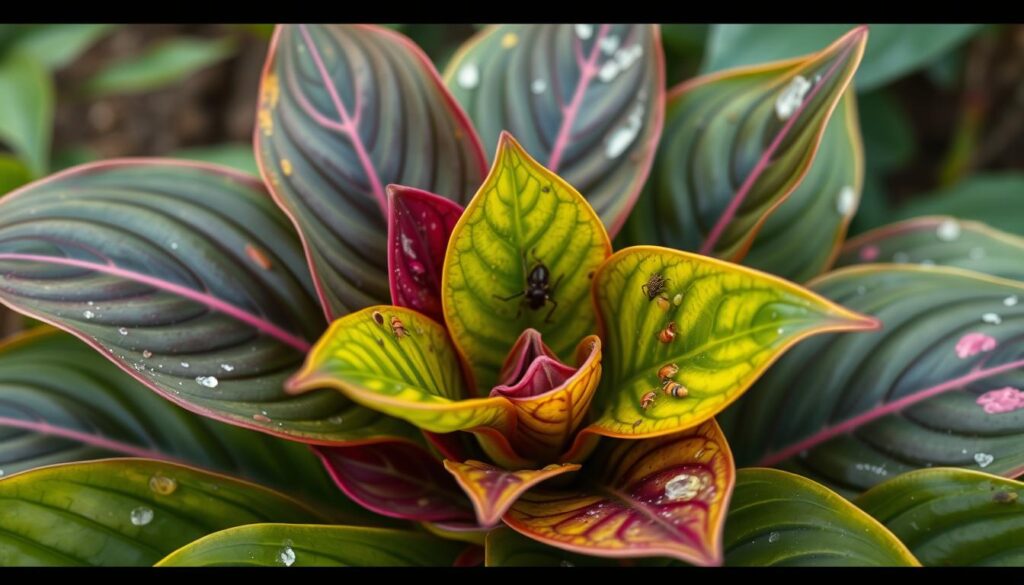
- Check your plant often for signs of trouble
- Keep air moving and don’t overwater
- Use insecticidal soap or neem oil for pests
- Make sure soil drains well and isn’t too wet
- Watch your plant’s temperature and humidity
Knowing about pests and diseases helps keep your plant healthy. Always check your plant and act fast if you see problems.
Pruning and Propagating Your Prayer Plant
To keep your Prayer Plant looking good, you need to prune it often. This means taking off dead leaves and cutting long stems. This helps the plant grow bushy. The best time to prune is in spring and summer when it’s growing fast.
There are two ways to propagate your Prayer Plant. You can divide it or use stem cuttings. Dividing means splitting the plant at the roots. Stem cuttings are when you take a stem with leaves and put it in water or soil to grow roots.
Simple Methods for Propagation
- Division: separate the plant at the roots into smaller sections
- Stem cuttings: take a healthy stem with several leaves and nodes, and place it in water or a moist potting mix
By pruning and propagating your Prayer Plant, you keep it healthy and looking good. Use sharp tools for clean cuts. Don’t fertilize right after pruning to avoid stressing the plant.
When to Prune for Healthy Growth
Prune your Prayer Plant twice a year to keep it healthy. Prune in early spring after it wakes up from winter. By pruning and propagating, your Prayer Plant will stay beautiful and move well for many years.
| Pruning Frequency | Optimal Seasons |
|---|---|
| Twice a year | Spring and summer |
Troubleshooting Common Prayer Plant Issues
When you care for your prayer plant, you might see yellowing leaves. This can happen from too much water, too little water, or not enough nutrients. First, check if the soil is too wet or dry. Then, adjust how often you water it. Also, make sure to feed it with a balanced fertilizer.
For more help with yellowing leaves, check out this resource. It talks about other problems like curled leaves, brown leaves, and droopy leaves. These can come from low humidity, too much sun, or being too small in its pot.
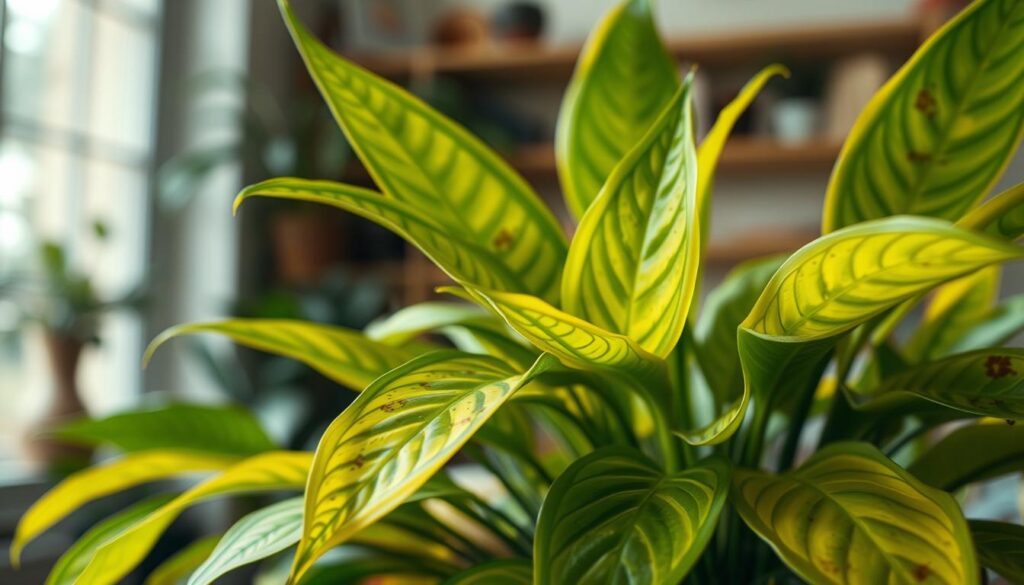
To avoid these problems, give your prayer plant what it needs. This includes the right light, water, and food. Here are some tips to keep your plant happy and healthy:
* Always check the soil moisture to water right.
* Give it bright, indirect light to avoid burning.
* Keep the temperature between 65-80°F (18-27°C).
* Feed it regularly when it’s growing.
* Repot it every year to give it fresh soil and a bigger home.
By following these steps and watching out for common issues, your prayer plant will stay beautiful and healthy for a long time.
Enhancing Decor with Your Prayer Plant
Your prayer plant makes your home look beautiful. It moves its leaves in a special way and has bright colors. This makes any room look fancy.
To make a creative display, put your prayer plant with other plants. Ferns or peace lilies look good with it. They make a lush and colorful spot.
Here are some ways to enhance decor with your prayer plant:
- Displaying it on a shelf or in a hanging basket
- Using decorative planters or pots to add a touch of elegance
- Creating a centerpiece with your prayer plant as the focal point
Being creative with your prayer plant can make your home special. It adds a personal touch.
The Benefits of Having a Prayer Plant in Your Home
Adding a Prayer Plant to your home has many perks. It’s safe for pets, so you don’t have to worry. It also cleans the air by removing harmful toxins.
This makes your home healthier and greener. It’s a win-win for you and your family.
Non-Toxic Nature for Pet Owners
The Prayer Plant is safe for pets. It’s different from many plants that can harm cats and dogs. So, you can enjoy its beauty without worrying about your pets.
Air Purification Properties of Prayer Plants
The Prayer Plant is good for the air too. It helps clean indoor air, even if it’s not on NASA’s list. It can take out bad stuff like formaldehyde and benzene.
This makes your home a better place to be. It’s a great addition to any home.


